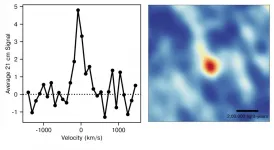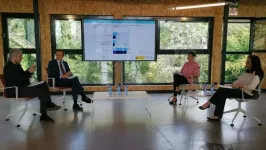(Press-News.org) A team of astronomers from the National Centre for Radio Astrophysics (NCRA-TIFR) in Pune, and the Raman Research Institute (RRI), in Bangalore, has used the Giant Metrewave Radio Telescope (GMRT) to measure the atomic hydrogen gas content of galaxies 9 billion years ago, in the young universe. This is the earliest epoch in the universe for which there is a measurement of the atomic hydrogen content of galaxies. The new result is a crucial confirmation of the group's earlier result, where they had measured the atomic hydrogen content of galaxies 8 billion years ago, and pushes our understanding of galaxies to even earlier in the universe. The new research has been published in the 2 June 2021 issue of The Astrophysical Journal Letters.
Galaxies consist of mostly gas and stars, with new stars forming from the existing gas during the life of a galaxy. Stars formed much more frequently when the universe was young than they do today. Astronomers have known for more than two decades that the star formation activity in galaxies was at its highest about 8-10 billion years ago, and has declined steadily thereafter. Until recently, the cause of this decline was unknown, mostly because we have had no information about the amount of atomic hydrogen gas, the main fuel for star formation, in galaxies at these early times. This changed last year when a team of astronomers from NCRA and RRI, including some of the authors from the present study, used the upgraded GMRT to obtain the first measurement of the atomic hydrogen gas content of galaxies about 8 billion years ago, when the star-formation activity of the Universe began to decline. They found that the likely cause for the decline in star formation in galaxies is that galaxies were running out of fuel.
Aditya Chowdhury, a Ph.D. student at NCRA-TIFR, and the lead author of both the new study and the 2020 one, said, "Our new results are for galaxies at even earlier times, but still towards the end of the epoch of maximum star-formation activity. We find that galaxies 9 billion years ago were rich in atomic gas, with nearly three times as much mass in atomic gas as in stars! This is very different from galaxies today like the Milky Way, where the gas mass is nearly ten times smaller than the mass in stars."
The measurement of the atomic hydrogen gas mass was done by using the GMRT to search for a spectral line in atomic hydrogen, which can only be detected with radio telescopes. Unfortunately, this "21 cm" signal is very weak, and hence nearly impossible to detect from individual galaxies at such large distances, around 30 billion light years from us, even with powerful telescopes like the GMRT. The team hence used a technique called "stacking" to improve the sensitivity. This allowed them to measure the average gas content of nearly 3,000 galaxies, by combining their 21 cm signals.
"The observations of our study were carried out around 5 years ago, before the GMRT was upgraded in 2018. We used the original receivers and electronics chain of the GMRT before its upgrade, which had a narrow bandwidth. We could hence cover only a limited number of galaxies; this is why our current study covers 3000 galaxies, compared to the 8,000 galaxies of our 2020 study with the wider bandwidth of the upgraded GMRT.", said Nissim Kanekar of NCRA-TIFR, a co-author of the study.
Barnali Das, another Ph.D. student of NCRA-TIFR, added, "Although we had fewer galaxies, we increased our sensitivity by observing for longer, with nearly 400 hours of observations. The large volume of data meant that the analysis took a long time!".
"The star formation in these early galaxies is so intense that they would consume their atomic gas in just two billion years. And, if the galaxies could not acquire more gas, their star formation activity would decline, and finally cease.", said Chowdhury. "It thus appears likely that the cause of the declining star-formation in the Universe is simply that galaxies were not able to replenish their gas reservoirs after some epoch, probably because there wasn't enough gas available in their environments."
"Reproducibility is foundational to science! Last year, we reported the first measurement of the atomic gas content in such distant galaxies. With the present result, using a completely different set of receivers and electronics, we now have two independent measurements of the atomic gas mass in these early galaxies. This would have been hard to believe, even a few years ago!", said Kanekar.
K. S. Dwarakanath of RRI, a co-author of the study, mentioned "Detecting the 21 cm signal from distant galaxies was the main original goal of the GMRT, and continues to be a key science driver for building even more powerful telescopes like the Square Kilometre Array. These results are extremely important for our understanding of galaxy evolution.".
INFORMATION:
The research was carried out by Aditya Chowdhury, Nissim Kanekar, and Barnali Das of NCRA-TIFR, and Shiv Sethi and K. S. Dwarakanath of RRI. The Giant Metrewave Radio Telescope was built and is operated by NCRA-TIFR. The research was funded by the Department of Atomic Energy, India, and the Department of Science and Technology, India.
Decades of research has revealed the remarkable morphological adaptations of sea snakes to aquatic life, which include paddle-shaped tails, salt-excreting glands, and the ability to breathe through their skin.
In a new study published in Biological Journal of the Linnean Society, researchers at the University of Adelaide detail the enlarged touch receptors that evolved in male turtle-headed sea snakes (Emydocephalus annulatus), to help them locate and court females in aquatic environments.
Lead author, Jenna Crowe-Riddell, PhD graduate at the University of Adelaide's School of Biological Sciences, says on land, snakes use tongue-flicking ...
Older people need digital skills training to learn to use digital technology more independently, but they also seek digital training opportunities because of the social benefits they offer, according to a recent study from the University of Eastern Finland. Published in International Journal of Lifelong Education, the study examined perceived benefits of digital skills training among older adult learners, their teachers and peer tutors. Data for the study were collected in liberal adult education organisations, such as community colleges, as well as in peer tutoring sessions organised by third sector actors.
New skills and friendships
The coronavirus pandemic has, for its part, highlighted inequalities in the availability and ...
The Amami, Okinawa region of Japan may be designated a World Heritage Site in July of 2021 based on the recent recommendation from the IUCN. The Iriomote wild cat is a symbolic species of the region, having evolved independently on the island. The area is home to many other highly endemic and unique evolutionary species. A research group comprised mostly of former students of Professor Koji Tojo's Faculty of Science lab of Shinshu University focused on the study of dragonflies, continuing from their previous study of their comparative embryogenesis. About 5,000 species of insects belonging to 26 families of the order Dragonfly are known ...
A long-standing basic question in biology relates to how life satisfies the fundamental constraints put on it by physics and chemistry. Darwin's warm pond hypothesis for the origin of primordial cells is a familiar one. Advances have been made in mapping out the organic molecules that likely existed on the early Earth, and recently candidate prototypic pathways in early cells have been formulated. But how did these candidates' early biochemistry actually function as a system, on which subsequent cellular life is based?
A team of bioengineers at the Novo Nordisk Foundation Center for Biosustainability, DTU, has now defined ten overarching classes of constraints on early metabolic ...
A minimally-invasive procedure that targets the nerves near the kidney has been found to significantly reduce blood pressure in hypertension patients, according to the results of a global multicentre clinical trial led in the UK by researchers at Queen Mary University of London and Barts Health NHS Trust.
The study, published in The Lancet and presented at the American College of Cardiology meeting, suggests that the procedure could offer hope to patients with high blood pressure who do not respond to recommended treatments (resistant hypertension), and are at greatly increased risk of cardiovascular diseases, including stroke and heart attack.
The international clinical trial tested a one-hour procedure called 'renal denervation', which uses ultrasound energy to ...
The fluorescence dyes were dominant species of the near-infrared (NIR) dyes, but the energy gap of the NIR dyes between S1 state and S0 state is generally small to induce the ultrafast internal conversion dynamics to quench the NIR emission of the fluorescence dyes. Therefore, the quantum yield of the fluorescence NIR dyes is usually low. On the other hand, the organic dyes with room-temperature phosphorescence (RTP) in the NIR region could prevent the ultrafast internal conversion dynamics quenching because of the T1 state and S0 state the organic molecules are spin forbidden.
Recently, scientists in China reported a new assumption to construct ...
The Spanish Foundation for Science and Technology (FECYT) has presented this week at the headquarters of the National Science and Technology Museum in Madrid the main results of the 10th Social Perception of Science Survey carried out in 2020.
The presentation was attended by Pedro Duque, Minister of Science and Innovation, Josep Lobera, Professor of Sociology at the Autonomous University of Madrid (UAM) and scientific co-director of the Survey and the subsequent study, and Rosa Capeáns, Director of the Scientific Culture and Innovation Department of FECYT. Pampa García, Editor-in-Chief of the SINC Agency, moderated a debate in which the results were presented in six blocks: Interest in ...
In the present study, Dr. Hidetoshi Hayashi (Professor, Nagoya City University) and collaborators screened small-molecule compounds that suppress UPR, using Myanmar wild plant extracts library. The screening system to track X-box binding protein 1 (XBP1) splicing activity revealed that the ethanol extract of the Periploca calophylla stem inhibited the inositol-requiring enzyme 1 (IRE1)-XBP1 pathway. They isolated and identified periplocin as a potent inhibitor of the IRE1-XBP1 axis. Periplocin also suppressed other UPR axes, protein kinase R-like endoplasmic reticulum kinase (PERK), and activating transcription ...
Researchers from the Hubrecht Institute in Utrecht (The Netherlands) and the Max Planck Institute for Molecular Biomedicine in Münster (Germany) used computer simulations to reveal in atomic detail how a short piece of DNA opens while it is tightly wrapped around the proteins that package our genome. These simulations provide unprecedented insights into the mechanisms that regulate gene expression. The results were published in PLOS Computational Biology on the 3rd of June, 2021.
Every cell in the body contains two meters of DNA. In order to fit all the DNA ...
Health has always been affected by climate and weather, but is increasingly clear that the change in climate is a significant threat to human health. The World Health Organization (WHO) estimates that 24% of global deaths are linked to environmental factors [1]. Climate change and pollution can lead to undernutrition, mental disorders, and noncommunicable diseases including chronic kidney disease and acute kidney injury [2].
The burden of addressing the death and disability associated with climate change falls to nephrologists and other healthcare professionals. At the same time, the healthcare sector makes a major ...






